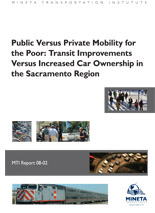- 408-924-7560
- mineta-institute@sjsu.edu
- Donate
Public Versus Private Mobility for the Poor: Transit Improvements Versus Increased Car Ownership in the Sacramento Region
Whether to aid welfare recipients in overcoming transportation barriers with increased car ownership or better transit became an issue after the Personal Responsibility and Work Opportunity Reconciliation Act of 1996 was signed into law. Empirical studies pointed out that welfare recipients owning a car had a high probability of moving from welfare to work. In this study, the authors examined the impacts of car ownership promotion versus transit improvements on job accessibility, work trips, and traveler´s economic welfare by running a travel demand model adopted by the Sacramento Area Council of Governments (SACOG). In the car scenario, the zero-car households who were assigned a car had higher job accessibility and larger traveler benefits than in the Base Case scenario. The other households had lower traveler benefits, compared to the Base Case, due to slight increases in congestion. In the transit scenario, all households had gains in traveler benefits and the households without a car gained more than those with a car. The households without a car gained more in traveler benefits in the transit scenario than in the car scenario. The total gain in traveler benefits was higher in the transit scenario. In both scenarios, the changes in total travel time, congestion, and vehicle miles traveled (VMT) were small, but mode shares changed substantially.
ROBERT A. JOHNSTON
Robert A. Johnston is an emeritus professor in the Department of Environmental Science and Policy at the University of California, Davis, where he also serves as a faculty researcher at UCD´s Institute of Transportation Studies. Current consulting involves the evaluation of regional travel demand models and land use models for public and private clients and reviews of environmental assessments of large projects. He has been an expert witness in several National Environmental Policy Act (NEPA) lawsuits. Johnston´s current research involves applying an integrated urban model to California. Johnston´s GIS–based urban growth model is being applied to about 20 rural counties in California for the California DOT. In 2006–07, Professor Johnston was on a National Academy of Sciences (NAS) committee that issued a book on the state of travel modeling in the United States. He recently developed a model for projecting energy use and greenhouse gases from general plans.
SHENGYI GAO
Shengyi Gao is a postdoctoral researcher in the Information Center for the Environment, University of California, Davis. He received his PhD in Transportation Technology and Policy from UC Davis in 2006. His research interests include the relationships between land use and transportation, transportation equity, urban growth modeling, and application of geographic information system technology in transportation and land use planning. He is currently working on the California Production, Exchange, and Consumption.
-
Contact Us
San José State University One Washington Square, San Jose, CA 95192 Phone: 408-924-7560 Email: mineta-institute@sjsu.edu






